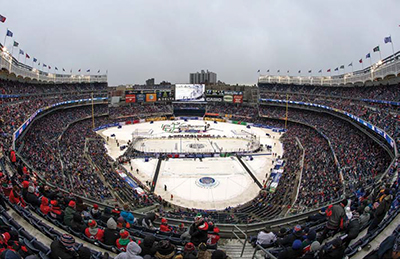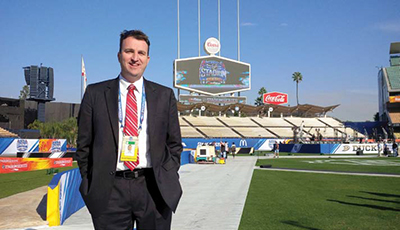NHL Expands Outdoor Games Schedule

In a first for Yankee Stadium, the New York Rangers and the New Jersey Devils battled it out during the Coors Light NHL Stadium Series at the home of the Bronx Bombers last month.
OTTAWA—For 60 years, Canada’s CBC-TV has been broadcasting NHL games via its Hockey Night in Canada production unit. But the problems HNIC faced when covering the Jan. 26, 2014 matchup between the New York Rangers and the New Jersey Devils were definitely not what they were accustomed to. That’s because this afternoon game was held outdoors at Yankee Stadium, during the midst of the “polar vortex” that was super-chilling the Eastern seaboard. As a result, the HNIC crew had to deal with below-freezing temperatures, frigid winds, and snow showers.
But the biggest issue wasn’t the cold but rather the intense sunlight reflecting off the ice surface, which blinded players and cameras alike. It was so bad, that “we had to delay the puck drop by about 35 minutes because of the glare,” said Joel Darling, HNIC’s executive producer. The subsequent arrival of clouds was a relief, even though they dumped snow on the ice during the second period. The Rangers won the game 7-3.
ADVENTURES IN BROADCASTING
Weather was just one of the challenges faced by the HNIC crew, which has been shooting regular season outdoor games since the NHL launched the 2003 Heritage Classic between the Montreal Canadians and the Edmonton Oilers at Edmonton’s open-air Commonwealth Stadium, home to the Edmonton Eskimos Canadian Football League team.

Joel Darling, executive producer for “Hockey Night In Canada” Compared to the outdoor conditions of that game, last month’s match in New York was comparatively balmy. The temperature at Commonwealth Stadium during the 2003 Heritage Classic was –22 degrees below zero (once the wind chill was factored in). For the record, the Canadians beat the Oilers with a score of 4-3.
The 2003 game also marked the first high-definition NHL game shown on CBC, according to Darling. “Because we didn’t have our own HD mobile unit at that time, we had to bring in a Japanese game show truck based in New York City. Edmonton was so cold, our fiber-optic cables got brittle and kept snapping.”
The game in New York is part of the NHL’s “Coors Light NHL Stadium Series,” which consists of four games, two at Yankee Stadium, one at Dodger Stadium in Los Angeles and the final match next month at Soldier Field in Chicago between the Pittsburgh Penguins and Chicago Blackhawks. These games are distinct from the New Year’s Day “NHL Winter Classic” and “NHL Heritage Classic” outdoor games.
The professional video industry's #1 source for news, trends and product and tech information. Sign up below.
Normally, the HNIC crew (and their U.S. counterparts at NBC) shoot hockey games in arenas where camera positions, commentator/ production space, and the necessary production and cabling are already in place.
Shooting outdoor games, which are typically located at baseball or football stadiums, is a complete departure from HNIC’s indoor routine. “It’s always a new building to us,” said Darling. Because these venues are not designed for hockey’s 180-degree style of video coverage, “the biggest challenges are the sightlines and the camera positions,” he said.
A case in point: The Jan. 25, 2014 outdoor night game at Los Angeles’ Dodgers Stadium – between the Los Angeles Kings and the Anaheim Ducks—was played on a refrigerated ice surface laid out lengthwise between first and third base, close to home plate. “We were able to secure the camera positions at first and third,” said Darling. “But we had to find new positions for the rest of our cameras.”
Shooting an outdoor game in Los Angeles was pleasant, given that it was a comfortable 61 degrees on a clear California night, but comfort was hard to find in New York the next day. “Our people are out there for five to six hours, once you factor in pre-game preparations,” said Darling. “We had to make sure they were warmly dressed, properly fed, and comfortable for the entire run.”
FLEET OF TRUCKS
To cover these events, HNIC relies on a fleet of HD mobile trucks leased from CBC Mobile Productions, the for-profit mobile production arm of the CBC. At the New York game, HNIC used the company’s 53-foot Infinity HD trailer equipped with a Grass Valley Kalypso switcher, Calrec Artemis audio console, six Sony HDC- 1500 HH camera, two six-channel XT3 EVS servers, and a four channel Spotbox and X-File, supplemented by CBC Mobile’s Champion Production-B unit. In Los Angeles, HNIC used CBC Mobile’s Premiere HD unit, a 53-foot trailer with a Grass Kalypso switcher, SSL C100 audio console, three EVS six-channelXT2 servers and a mix of four Sony HDC-1000 and five HDC-1500 cameras.
“Whenever we can, we like to dress up the shoot,” Darling said. “For instance, for the upcoming NHL Heritage Classic in Vancouver on March 2—between the Canucks and the Ottawa Senators—we’ll be installing a CableCam at BC Place Stadium.”
HNIC’s crew will get a bit of a break for the Vancouver game. For one thing, BC Place Stadium has a retractable roof, with the stands being covered even when it is open. For another, March temperatures in this west coast Canadian city range from above freezing to the mid –40s, so HNIC’s crews should be relatively comfortable.
This said, Darling isn’t complaining about shooting NHL games in cold weather. In fact, he relishes the experience. “It’s a truly magical experience, what with the big crowds, the large venues, and even the weather and all that it brings,” he said. “Everyone—the fans, players, and our people— know that an outdoor NHL game is a really special event, and they all love being part of it.”
James Careless is an award-winning journalist who has written for TV Technology since the 1990s. He has covered HDTV from the days of the six competing HDTV formats that led to the 1993 Grand Alliance, and onwards through ATSC 3.0 and OTT. He also writes for Radio World, along with other publications in aerospace, defense, public safety, streaming media, plus the amusement park industry for something different.

